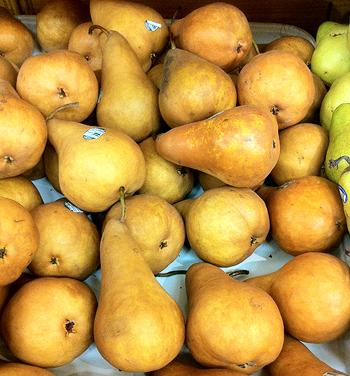 Bosc Pears
Bosc Pears© Denzil Green
Bosc pears have the classic pear shape — elongated, bird-like neck atop a full, bell-shaped base. Their russetted skin is browny-gold. Inside, the flesh is creamy-white with an almost spicy taste at times.
They are sold firmer than Bartletts or Anjous because they can be harvested and eaten earlier than either. Bosc pears develop their juiciness and flavour very early in the ripening process. Because of this, they hold their shape very well when cooked.
Varieties include Beurré Bosc, Calabasse Bosc, and Beurré d’Appremont. Other pears such as Comice, Orcs and Shipova are the best cross-pollinators for the Bosc trees.
In the United States, they thrive in the Northwest states such as Oregon and Washington.
Purchasing Bosc Pears
To tell if a Bosc is ripe, press the stem to see if it goes in a bit. Because they are firmer than other pears, you won’t feel as much give as you would with other pears. Sometimes under the russeting there will be a green cast that will turn more yellowish as the fruit matures, but not always, so colour is not a reliable indicator of ripeness. The best indication of ripeness is to smell them: they should be fragrant.
Cooking Tips
They are very good cooking pears and hold their shape well.
As with all pears, remove skin before cooking as it will go tough. Dip peeled pears in lemon water to stop the flesh from browning.
Storage Hints
Commercially, Bosc Pears are good keepers. They can keep in store houses for up to 6 months. At home, store in a plastic bag in the fridge for up to 5 days.
History Notes
Bosc are from Belgium or France. The Belgian origin version has them developing as a chance seedling raised in Belgium, in 1807, by a Mr M. Bosc. The French origin version has them being found as a chance seedling around 1830 in Appremont, France, and their being named after a M. Bosc, director of the Botanical Garden in Paris.
Bosc Pears were introduced to the eastern seaboard of America very early in the 1830s, probably 1832 or 1833, and were bearing fruit by 1836.
Literature and Lore
“Oregon oven-baked pears have made the headlines of the New York Herald Tribune’s daily food news column. On July 25 the metropolitan daily cited the “good cooks around Medford who serve the fine Beurre Bosc pears oven baked.”
Clementine Paddleford, food expert for the paper, told in her article how ‘Several of these women put the baked pears up in syrup [with] spices for an outstanding dessert, one that has created so much comment by visitors by the community that a pear grower conceived the idea of selling part of his crop canned in this fashion. This packer borrowed recipes from his neighbors and carried them to Oregon State college to see Professor E.H. Weigand, a pioneer in developing Oregon’s rare fruit specialties.
The professor liked the baked pear idea and undertook a series of tests baking them in every type of oven and in dozens of different ways. The college turned out 150 samples and the packer got up a jury of men and women to decide on the best. The choice was unanimous on one jar, the jar the packer sells today by mail.” — Pears Make Headlines. Corvallis, Oregon: Corvallis Gazette-Times. Tuesday, 1 August 1939. Page 3, col. 4.

